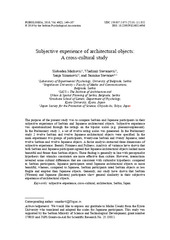Subjective experience of architectural objects: A cross-cultural study
Апстракт
The purpose of the present study was to compare Serbian and Japanese participants in their subjective experience of Serbian and Japanese architectural objects. Subjective experience was operationalized through the ratings on the bipolar scales (e.g. pleasant-unpleasant). In the Preliminary study 1, a set of twelve rating scales was generated. In the Preliminary study 2 twelve Serbian and twelve Japanese architectural objects were specified. In the main experiment two groups of participants, twenty-one Serbian and twenty Japanese, rated twelve Serbian and twelve Japanese objects. A factor analysis extracted three dimensions of subjective experience: Beauty, Firmness and Fullness. Analysis of variance have shown that both Serbian and Japanese participants agreed that Japanese architectural objects looked more beautiful and firmer than Serbian objects. These finding is generally in line with perceptualist hypothesis that stimulus constraints are more effective than culture. However, inter...actions revealed some cultural differences that are consistent with culturalist hypothesis: compared to Serbian participants, Japanese participants rated Japanese architectural objects as more beautiful, whereas, compared to Japanese, Serbian participants rated Serbian objects as less fragile and emptier than Japanese objects. Generally, our study have shown that Serbian (Western) and Japanese (Eastern) participants show general similarity in their subjective experience of architectural objects.
Кључне речи:
subjective experience / cross-cultural / architecture / Serbia / JapanИзвор:
Psihologija, 2016, 49, 2, 149-167Издавач:
- Drustvo Psihologa Srbije
Финансирање / пројекти:
- Фундаментални когнитивни процеси и функције (RS-MESTD-Basic Research (BR or ON)-179033)
- JSPS Grants-in-Aid for Scientific Research No. 25.13011
DOI: 10.2298/PSI1602149M
ISSN: 0048-5705
WoS: 000378174100003
Scopus: 2-s2.0-84982798928
Група
RAUmPlanTY - JOUR AU - Marković, Slobodan AU - Stevanović, Vladimir AU - Simonović, Sanja AU - Stevanov, Jasmina PY - 2016 UR - https://raumplan.iaus.ac.rs/handle/123456789/272 AB - The purpose of the present study was to compare Serbian and Japanese participants in their subjective experience of Serbian and Japanese architectural objects. Subjective experience was operationalized through the ratings on the bipolar scales (e.g. pleasant-unpleasant). In the Preliminary study 1, a set of twelve rating scales was generated. In the Preliminary study 2 twelve Serbian and twelve Japanese architectural objects were specified. In the main experiment two groups of participants, twenty-one Serbian and twenty Japanese, rated twelve Serbian and twelve Japanese objects. A factor analysis extracted three dimensions of subjective experience: Beauty, Firmness and Fullness. Analysis of variance have shown that both Serbian and Japanese participants agreed that Japanese architectural objects looked more beautiful and firmer than Serbian objects. These finding is generally in line with perceptualist hypothesis that stimulus constraints are more effective than culture. However, interactions revealed some cultural differences that are consistent with culturalist hypothesis: compared to Serbian participants, Japanese participants rated Japanese architectural objects as more beautiful, whereas, compared to Japanese, Serbian participants rated Serbian objects as less fragile and emptier than Japanese objects. Generally, our study have shown that Serbian (Western) and Japanese (Eastern) participants show general similarity in their subjective experience of architectural objects. PB - Drustvo Psihologa Srbije T2 - Psihologija T1 - Subjective experience of architectural objects: A cross-cultural study VL - 49 IS - 2 SP - 149 EP - 167 DO - 10.2298/PSI1602149M ER -
@article{
author = "Marković, Slobodan and Stevanović, Vladimir and Simonović, Sanja and Stevanov, Jasmina",
year = "2016",
abstract = "The purpose of the present study was to compare Serbian and Japanese participants in their subjective experience of Serbian and Japanese architectural objects. Subjective experience was operationalized through the ratings on the bipolar scales (e.g. pleasant-unpleasant). In the Preliminary study 1, a set of twelve rating scales was generated. In the Preliminary study 2 twelve Serbian and twelve Japanese architectural objects were specified. In the main experiment two groups of participants, twenty-one Serbian and twenty Japanese, rated twelve Serbian and twelve Japanese objects. A factor analysis extracted three dimensions of subjective experience: Beauty, Firmness and Fullness. Analysis of variance have shown that both Serbian and Japanese participants agreed that Japanese architectural objects looked more beautiful and firmer than Serbian objects. These finding is generally in line with perceptualist hypothesis that stimulus constraints are more effective than culture. However, interactions revealed some cultural differences that are consistent with culturalist hypothesis: compared to Serbian participants, Japanese participants rated Japanese architectural objects as more beautiful, whereas, compared to Japanese, Serbian participants rated Serbian objects as less fragile and emptier than Japanese objects. Generally, our study have shown that Serbian (Western) and Japanese (Eastern) participants show general similarity in their subjective experience of architectural objects.",
publisher = "Drustvo Psihologa Srbije",
journal = "Psihologija",
title = "Subjective experience of architectural objects: A cross-cultural study",
volume = "49",
number = "2",
pages = "149-167",
doi = "10.2298/PSI1602149M"
}
Marković, S., Stevanović, V., Simonović, S.,& Stevanov, J.. (2016). Subjective experience of architectural objects: A cross-cultural study. in Psihologija Drustvo Psihologa Srbije., 49(2), 149-167. https://doi.org/10.2298/PSI1602149M
Marković S, Stevanović V, Simonović S, Stevanov J. Subjective experience of architectural objects: A cross-cultural study. in Psihologija. 2016;49(2):149-167. doi:10.2298/PSI1602149M .
Marković, Slobodan, Stevanović, Vladimir, Simonović, Sanja, Stevanov, Jasmina, "Subjective experience of architectural objects: A cross-cultural study" in Psihologija, 49, no. 2 (2016):149-167, https://doi.org/10.2298/PSI1602149M . .



